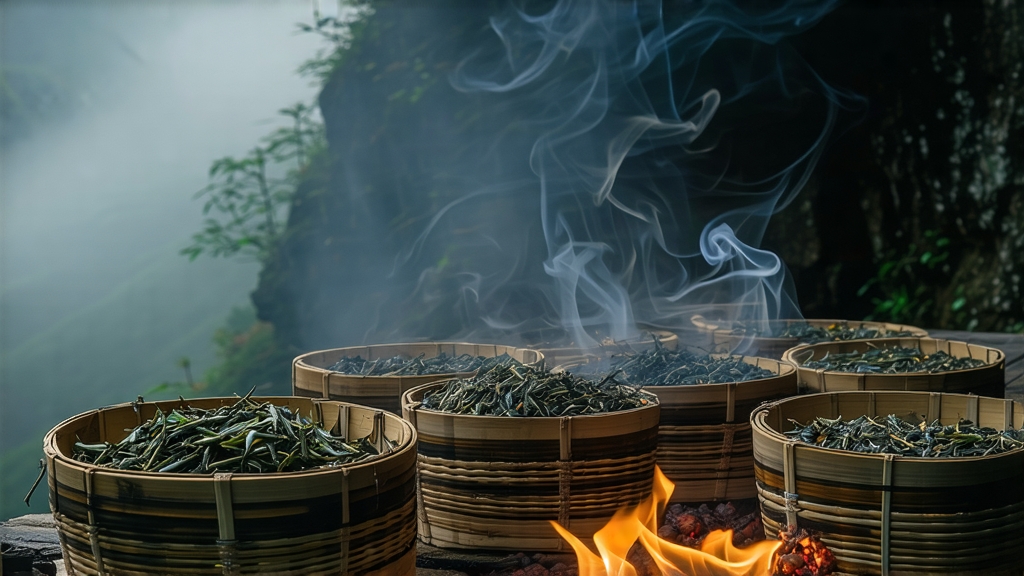
Ask most tea lovers outside China to name a Chinese black tea and the answer is often “Keemun” or “Yunnan Gold.” Few realize that the very first black tea ever created—long before those famous styles emerged—was Lapsang Souchong, a small-leaf cultivar born in the precipitous Wuyi Mountains of northern Fujian. Revered at home as Zheng Shan Xiao Zhong, and feared by some novices for its assertive campfire aroma, Lapsang Souchong is both the progenitor of every Chinese red (black) tea and a living testament to the ingenuity of 17th-century tea masters who learned to bend smoke, fire and time into liquid history.
Historical roots
Local legend fixes the birth year at 1646, when Qing troops descended on Tongmu Village, forcing farmers to rush their freshly picked tea past the normal sun-withering stage. In desperation the leaves were dried over green pine fires so the army could not requisition them. The accidental smoke infusion proved wildly popular with Dutch traders in Xiamen, who christened the tea “Bohea” (from the Min-dialect name for Wuyi) and shipped it to Europe just as London’s coffeehouses were searching for a patriotic alternative to Chinese green teas. By 1700 Lapsang Souchong had become the first black tea ever drunk in England, laying the commercial groundwork for the later Assam and Ceylon industries. The East India Company paid in silver, not opium, so valuable were those tightly rolled, tar-black leaves that smelled of pine resin and longan.
Terroir and cultivar
Authentic Lapsang Souchong can only be produced within the 600–1,200 m core zone of Wuyi’s national park, an amphitheatre of granite cliffs and subtropical forest where morning mist filters UV light and locks humidity at 80 %. The indigenous cultivar is Xiao Ye Zhong (“small-leaf species”), a slow-growing shrub whose leaves are barely 3 cm long yet concentrate sugars and amino acids in the cool gorge air. The same rocky, mineral-rich soils that give Wuyi oolocks their “yan yun” (rock rhyme) impart a subtle flinty note to the black tea, preventing the smoke from dominating the cup.
Two families, two styles
Today Tongmu villagers distinguish between two versions. “Zheng Shan” (original mountain) is the unsmoked heritage style, dried only over gentle charcoal embers of local hardwood; it tastes of dried longan, honey and wet slate. “Wai Shan” (outside mountain) is the export classic, briefly withered, rolled, then smoked for 6–8 hours above pinewood fires until the leaf surface reaches 70 °C. A third, modern “tar-free” variation uses far-infrared heat to mimic the chemical profile of smoke without polycyclic aromatics, catering to EU residue limits while preserving the nostalgic scent that once perfumed London drawing rooms.
Crafting the smoke
The smoking shed is a dark, low-beamed structure whose floor is lined with 30 cm of local Masson pine that has aged one year to reduce sap. After the enzymatic oxidation (fermentation) phase is arrested at 80 % by a 220 °C “sha qing” roast, the semi-dry leaves are spread on bamboo sieves stacked 2 m above the smouldering pile. Artisans control airflow through narrow brick vents, ensuring the pine burns without flame; a single degree too hot and the leaf sugars caramelize into bitterness. Every twenty minutes the trays are rotated, allowing smoke to kiss each curl evenly. Eight hours later the leaves have lost 70 % of their moisture and absorbed α-pinene, camphene and bornyl acetate—the same terpenes that give rosemary and frankincense their resinous lift. A final charcoal bake sets the aroma for decades of aging potential.
Grading the leaf
European importers once classified Lapsang by numeric suffixes—PS, Pekoe, Orange Pekoe—but Tongmu farmers use a simpler code tied to pluck standard. “Ji Pin” (supreme) contains only the single bud immediately below the leaf; “Te Ji” (special grade) keeps the bud plus the first unfolded leaf; “Yi Ji” (first grade) allows two leaves and a bud. Higher grades receive shorter smoke exposure so the natural honey aroma can compete with the pine. When brewed, Ji Pin steeps a translucent amber liquor